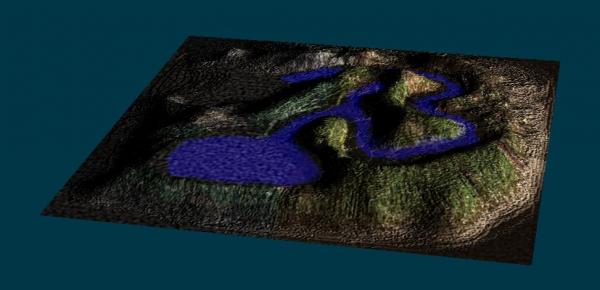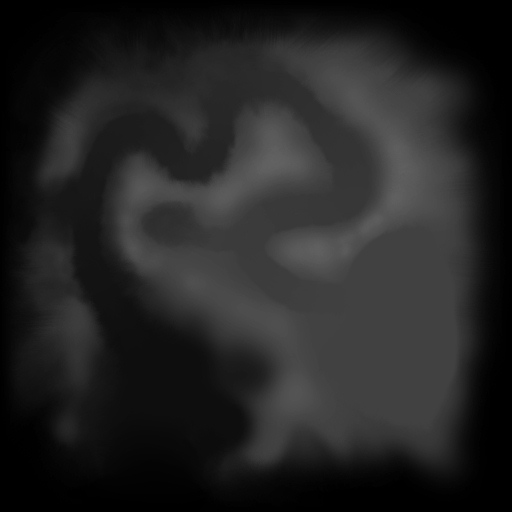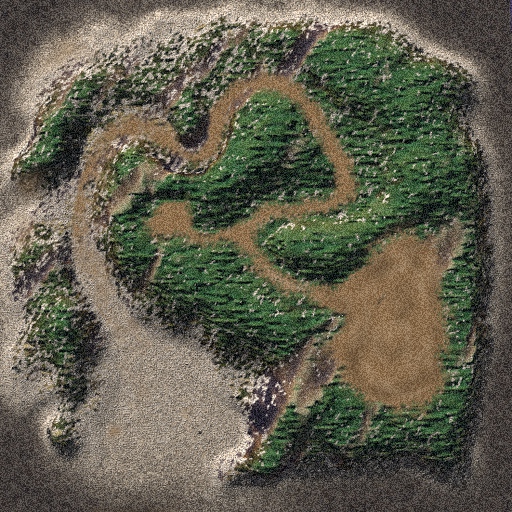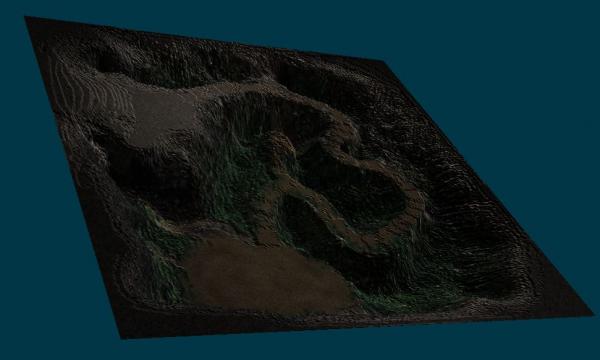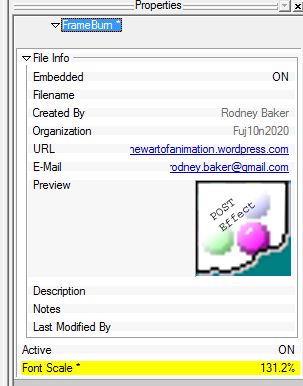-
Posts
21,649 -
Joined
-
Last visited
-
Days Won
119
Content Type
Profiles
Forums
Events
Everything posted by Rodney
-
That would be most awesome. Thanks for fixing that. I was wondering where it had gone off to...
-
Is there a particular reason that property appeals to you or an approach that would make it an ideal community production? In other words, why 'James and the Giant Peach' as opposed to another property? Added: Unless creating an homage of sorts I don't expect gaining the rights to the property would be cheap. I'm not sure how it would work but perhaps such a thing might fall into the realm of a 'play' adaptation (link). Although note that royalties for play production outside of K-12 schools is driven by estimated ticket sales. Regarding how the film got made I find this snippet:
-
Is that mostly displacement?
-
I should have said 'leaving frames out of the sequence'. In other words, setting the step option to some other number than 1 in the Render Options. I was playing with options of Multipass and Motion Blur too but my patience level wasn't sufficient. I don't know how effective that method is as I've been running into odd behavior of other sorts. I keep thinking I've got some settings that work well only to find out they don't. Example: A:M wants to keep computing dynamics for every frame of the Chor so I set the frame range to 1 frame for the length. This seems (seemed?) to suspend the computing of dynamics but then... it didn't.
-
Ouch. Well, that would explain why A:M was 'locking up' on me when using small size particles. Regarding the jittering... I was experimenting with stepped rendering and in my test that helped tame that considerably. The idea being to render every five frames or so out of the sequence rather than every frame.
-
I'm going to guess that using 64bit A:M is preferred when using Fluids as that allows for the use of more memory?
-
I like that last very last one.
-
It's all hush hush mysterious. (Gotta get that word o' mouth round of purchasing through the online community first, then the official announcement can be made) I have to hand it to them... they do know how to raise cash while generating buzz. They've been quite good at that over the years. They got $10 from me during their last major campaign... wonder how many others did the same... After an initial look I never used the program again.
-
I'd definitely call that progress.
-
The produced files (resulting products) aren't effected. The change only relates to the recorded data within Camtasia. Note: This appears to be one of several updates Techsmith is planning to bridge the gap between PC and Mac compatibility. Currently -Project Files- are not transferrable between PC/Mac but as of this release the recording sessions are. A future update should see the Project Files themselves move to cross platform compatibility but I suspect this will require a fairly major update to the Project File formatting. As long as the recorded data is the same... at least the ingested data can be shared. This should remind us of how nice it is that A:M's file format is the same on both platforms.
-
We are seeing more and more of these type of applications... a definite trend in collaborative software. While useful and interesting once online sketching is ubiquitous I imagine many of these application will either fade from existence or be assimilated into other products. I fully expect Youtube and other video services to move in that direction as well. But... in the meantime these application are available and can help bring collaborative projects to life. Like several similar offerings SyncSketch provides online annotation of video uploaded to the cloud. Sharing a link with someone else allows you to then share that information with others. Here are a few videos that outline the workflow: Use of syncsketch is free but a Pro version with additional features is planned: http://syncsketch.com/ One thing SyncSketch offers that I haven't seen in other similar applications is the ability to easily 'alter' the imagery by sampling color from the video. That's a useful feature. An alternative online application with similar features and workflow is RGBNotes.
-
This is for folks that use TechSmith's Camtasia screen recording software. With the recent update to Camtasia 8.4 the recording file format has changed to allow full compatibility between PC and Mac. Good news. The bad news is that this change makes files recorded in the latest release incompatible with earlier releases. You can't open them, etc. This is something to consider if you use more than one release version of Camtasia or work with other who do. Note that a general workaround is to save/produce the content as a video file and share that but all of the specialized recording data (mouse movement etc.) will be lost (flattened?) as you do. Also noted, Camtasia is still a 32bit application so keep in mind that RAM is limited to 3GB. They are working toward a 64bit version but I wouldn't expect to see that until at least the next major release (v9). The workaround to memory limitation is generally divide and conquer by cutting your project into smaller pieces. ...and as a bonus for reading through all that, TechSmith does provide some free music for use with creating videos. The music is available in several lengths (intro, medium and long) in zipped files: http://www.techsmith.com/camtasia-library-media-music-tracks.html Note that although the file extension may appear otherwise the files are just zip files containing the music.
-
For those keeping track... Lightworks version 12 has been released for PC, Mac and Linux. While the free version is still available on all platforms there has been a change to licensing of the full release (driven by increased cost of codec licensing according to the folks at EditShare). With this release, gone is the regular subscription which is replaced by monthly, yearly or outright purchase. Month License: £14.99 | €19.99 | $24.99 Year License: £99.99 | €134.99 | $174.99 Outright: £249.99 | €337.99 | $437.99 The primary difference between paid and free licencing is the access to the higher end codecs. The free version exports/saves to .MP4 (standard format used with Youtube, Vimeo etc. [Web-compatible file (MPEG4/H.264 - max. resolution: 1280x720p pixels) with optional upload direct to Youtube] ) although it can import other formats. Import formats (for both free and Pro) include: DVCAM / DVCPRO 25 DVCPRO 50 DVCPRO HD Uncompressed SD 8 bit and 10 bit Uncompressed HD 8 bit and 10 bit MPEG-2 I-Frame SD MPEG-2 I-Frame HD MPEG-2 Long GOP IMX 30, 40, 50 AVCHD (M2T, M2TS, MPEG4, H.264) Avid DNxHD – all variants, including Thin Raster** AVC-Intra 50 AVC-Intra 100 XDCAM EX (native MP4 support) XDCAM HD XDCAM HD 50 422 Apple Pro Res RED R3D DPX 8 bit, 10 bit, 16 bit Image Sequence (BMP, DPX, JPEG, PNG, TGA, Compressed TGA, TIFF) Broadcast Wave Format with drop and non-drop frame timecode options At any rate, for those without a dedicated video editor (on PC, Mac or Linux) Lightworks is well worth a look. Here's one of many videos from the Lightworks youtube channel:
-
This is an area where lots of folk get confused and it's largely because of the way Adobe/Photoshop handles transparency/Alpha Channels. In short, black shouldn't be transparent... it should be an empty (alpha) channel. A:M does have the transparency setting that can be set to allow for black to be transparent but... what if you want black in your image? The trick with many paint programs is to remove/delete/erase the background which then leaves everything not painted (in any color) transparent. To make matters a bit worse... the files can lose their transparency upon saving if one isn't careful to watch/understand the settings. This is one of the reasons I like to suggest using A:M to create imagery wherever possible because upon selecting 'Alpha Channel' A:M assumes you want a transparent background/alpha channel. This is unlike other programs which assume you want the background white (or some other set color). Contrast this to A:M's camera background which you can set all day long to whatever color you want but if you opt for an Alpha Channel it doesn't matter what color you set because wherever nothing exists will be transparent. This does get confusing because in order to show the alpha channel to the user it has to be some color (or in the case of Photoshop you'll see a checkerboard pattern). With many programs the alpha channel will display as black... because on the grayscale from white to black white represents 100% opaque while black represents 100% transparent. Okay... having said all of that... when it comes to displacement... yes, lighter colors are elevated. Consider mid gray to be zero elevation..... black to be lowest and white to be highest. If you use a color image it will use that color's grayscale equivalent. If you can, share an image of what you are working with and we can focus on that.
-
I dunno... the pacing there had to be fairly quick. It is a one minute 15 second animation test after all (15 seconds of which was the insert in the middle with the antics of the Jeep). Aside: The part with the Jeep almost seems to be a separate test within the test to me. Perhaps that part Genndy animated all by himself or it was farmed out as another specific test? Something is 'different' there but I can't quite put my finger on it. The whole sequence does play to contrasts in fast versus slow pacing considerably.) Genndy surely had some very specific things he wanted to test in that remaining minute with Popeye and Olive Oil (dialogue for instance... always something that will eat up a lot of time in animation). The slow paced stuff is tested at the very beginning (approx 15 seconds worth of set up the entire sequence... Olive Oil... being bored... wishing something of interest would happen)... This leaves 45 seconds left to tell a story full of pose to pose (in Genndy's style) with multiple acts of repeated gags to test how the physical humor will play out as well as how the faster paced stuff (again in Genndy signature pose to pose... almost stop motion... quirky style will read. And don't forget we need to see lots of highly exaggerated squash and stretch (which takes a lot of time the more exaggerated and punctuated the squash or the stretch)... and don't forget to keep those characters recognizable throughout the whole thing. That'd leave us with approx 15 seconds (450 frames) to play with slowing down the pace. At a guess I'd say those frames did exactly that in the moments when Genndy's stylistic holds are on display. The good news is that a 90 minute feature has considerably more room to play with pacing. Only time will tell but we could assume that very thing to be Genndy's goal here. I'm sure they learned much from the test that informed their way forward in the making of the feature film no doubt a big part of the test was to put the actual workflow through it's paces.. I'm mostly just glad it looks like the feature won't be full of characters we can't recognize. Disclaimer: I am only peripherally familiar with Genndy's work and have not yet seen 'Hotel Transylvania'. Most of what I know of him is from others describing his particular approach to animation that focuses on melding hitherto fore unseen 'hand drawn' elements into CG animation.
-
I believe the workaround to that would be to use multiple instances of a particle material (or a number of different particle materials all driving different sprite images in a scene). Perhaps even better, as you say, we can also use hair materials to drive the differences as we layer them in.
-
And of course we can then layer in additional detail by adding new images to the decals: (Here's a quickly added blue water level that uses the image's Ambiance Intensity setting)
-
I won't say the colors are to my liking but here's how the colors were made in the attached... A gradient material with the second of it's attributes changed to another gradient material acts as a gradient for three colors to appear based (primarily) on height. I toggled down the visibility of the color map from the previous decal but left the displacement map the same. So when the gradient material is adjusted/animated it 'paints' the terrain. I did remove the default Chor lighting and add a single Sun light as well. mod1.mov
-
In my estimation the secret to all texturing is layering. There are so many approaches to layering that it might help to see an image of something similar to the look you want. For the most part all you need is two layers to get most of the job accomplished; a height map (greyscale) and a color map. You can create that either in A:M or in a program like Photoshop. I'm adding two images to this post that I found randomly on the internet. They work pretty well out of the box with displacement (although there isn't really an element of granite mountains in it). My apologies if it's a bit dark. Assuming you didn't want to paint any textures in an another program I'd say you could use A:M to create something similar. Just use a copy of your terrain model rendered from the top view. Experiment with various colors in the gradient material but I recommend using high contrast colors to start with (Red... White... I dunno... Pink?) That will help to more quickly get the right results. Note that for the sake of testing you could also use patch color to define basic areas of interest but you'd have to have a really dense mesh to avoid the 'jaggies'. Edit: I should have flipped the normals on the grid.... I'll post another example as soon as it renders. .
-
Hey Rich, Two things come to mind; layers and natural flow. Natures flow (of wind, rain etc.) is what you are trying to emulate and layering a shortcut to get at that effect. It can help to think in terms of hard versus soft in that your granite material is likely going to be the hardest so you can place that first. If modeling it you build that with the thought that it is mostly immoveabe. Similarly if painted as a texture that is an area you want to define first. It might help to consider straight edges, blocky shapes etc. For the rocks we must assume they have either broken away from the granite or fallen away from topsoil that was once on top of the granite before. Considering gravity and the effects of (mostly) water we can plot a general course they will flow to be deposited in the area between the granite and the grassy plain below. Of course where the water moved the most will be where the dirt and smaller rocks tend to go. Some of those rocks and even a few strategically placed pieces of granite might then be found here and there amongst the grass. The grass then can only grow where it has dirt for it to take root and grow. In somewhat a reverse fashion from the rocks the grass thins out as it encounters less dirt and rockier terrain above. So with layering... Thinking mostly in terms of black and white first set down your granite. This is primarily a matter of elevation. It is above the ground plane (which we can assume is sloping) or it isn't. Then add your rock layer. This could be grayscale to indicate how far the rocks have moved away from their original source (i.e. black would represent the original location and white the farthest it has moved from the source.. Lastly add the soil layer and those things that will grow on it. Don't neglect to add some soil at higher elevation to provide places for random seeds of life to grow. The above is a bit more cerebral that it needs to be and basically you are just taking your three elements (granite, smoother rocks and grass) and layering them over each other. I do think when building terrain it's a good idea to consider how nature (or man) would have formed the area though. I should mention that gradient materials work well for some things like this. The classic example is the terrain from Brain Prince and Eggington Studios. The material textures the areas based primarily on elevation... so higher elevations would be granite colored while the lowest would be grassy green, etc. Brian's tutorial may be online somewhere...
-
Sony Picutures/Imageworks is pressing toward the release of an updated Popeye. Initially I was quite skeptical but if anyone can pull off a decent Popeye feature it's bound to be Genndy Tartakovsky. The 'animation test' begins after a short intro. I have never been a huge fan of Popeye although at times I almost became one when a story hinted at his potential. But I watched him a lot when I was a kid. As a kid of four or five years old I use to have a recurring nightmare where I was down in a deep well being chased by a shark and it wasn't until (by happenstance in my late teens) I saw an episode of Popeye where that scene played out with Popeye as the one confined to the well and fighting off the shark. Obviously my little mind must have empathized with Popeye's situation. I hadn't been traumatized but that dream had been so vivid. It was very strange to discover the origin of that experience. Another thought that occurred to my young mind was that some animated scenes seemed to be better/smoother than others and while I didn't have the language to explain that at the time I felt it surely had to do with different people involved with those parts of the story. If the Warner Bros cartoons were on I probably watched those instead but If I only had the choice between Popeye and Woody Woodpecker... Popeye won every time... because that crazy bird seriously gave me a headache. In later years I found myself wishing they would have played the Popeye TV series closer to the comic strip as that had an endless cast of characters I found (and still find) fascinating. The comic strip stories more than anything else is where I think they have serious franchise potential.
-
That's very good texturing! As a former maintainer of small arms I would be wary of firing that rifle without a thorough inspection first. From the outside it does look operational though! Nice job!
-
v17g was out over a year ago. We... well, some of us... are on v18f now (that 'f' at the end must have confused you) Although I expect Simon is referring to v17g+ which was a release for Mac only to allow for compatibility with Mavericks. ( LInk to v17g+) v17g+ effected no change for the PC release.
-
The Font Scale (Font Size) of the Frame Burn may not be available on the Mac. It is for the PC. An alternative (which we probably should promote here in the community) is an overlay/rotoscope that simply stamps the frames with name/frame and whatever other info is required. When Frame Burn moved from being a Camara setting to a Post Effect (circa v11?) it lost some of it's usefulness but the move was an good thing in that Post Effects could be more easily updated than coding camera attributes. Hash Inc wisely saw Frame Burn as a post effect and not something that needed to be built 'in camera.' Having said that, 'real time' overlays could work even better. An overlay would work bettter *and* that overlay could personalize the whole thing and/or add elements that help categorize where the shot is in production. For example, if a lower thirds type overlay/roto were placed at the bottom of the frame it could
-
Thought folks might get a kick out of this failed Proof of Concept: There does appear to be some post work done in this but the primary elments appear to be: 1 ) Fire spirals rotate one way while the smoke rotates in the opposite. 2 ) Fire spirals move up while the smoke spirals move down 3 ) The smoke spirals appear to be on an overlay that has a mask with circular opening at the bottom left (to allow the fire spirals to appear) Although particles could be used I think this is more of a repetition on 2D planes that is then composited. In other words... the fire spirals rendered moving upward. The smoke spirals rendered coming downward. The smoke then composited over the fire.. As for how the lighter lines turn to dark lines it looks to me as if the images are negatives of each other. In the fire the lines are white (or light color) and the centers black (or dark color) while in the smoke the lines are black (or dark color) while the centers white (or light color). The color is then added/composited over that. POC (fail).mov










